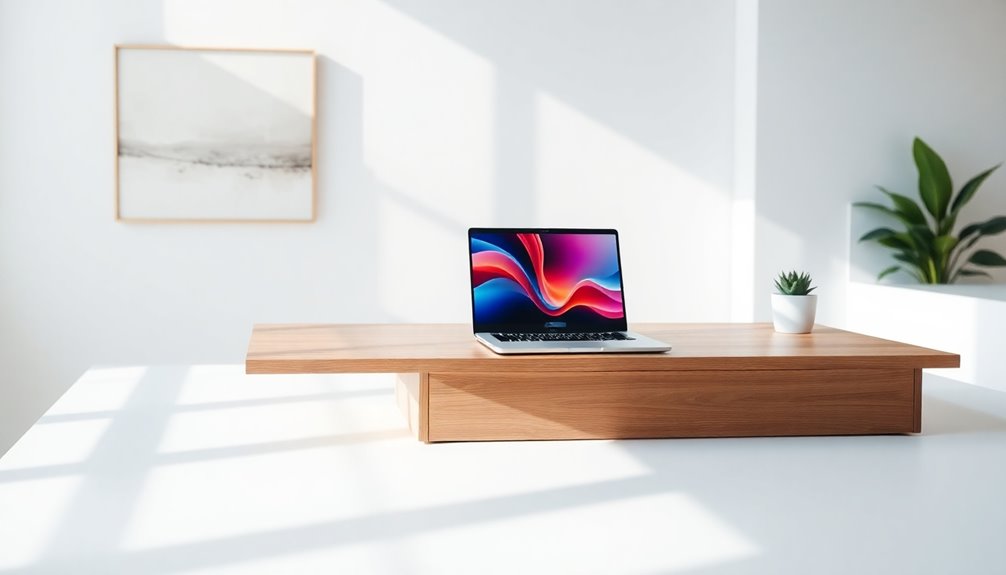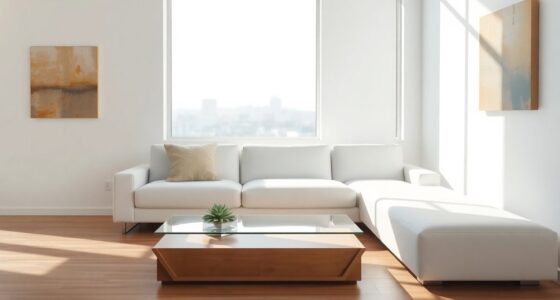Minimalist design is shaping the future of digital media by prioritizing clarity and simplicity, which enhances your overall user experience. You'll notice that clean layouts improve engagement and retention while reducing distractions. Fast load times and easy navigation make it easier for you to interact with content, leading to higher conversion rates. As brands shift toward bold typography and ample white space, you'll find the benefits of minimalism increasingly appealing. Explore how these trends can impact your digital journey.
Key Takeaways
- Minimalist design enhances user experience by prioritizing clarity and simplicity, making digital interfaces more intuitive and accessible.
- The increasing use of bold typography and monochrome color palettes creates visually striking yet uncluttered designs, enhancing user engagement.
- Whitespace improves readability and content focus, helping users retain information and navigate digital media more effectively.
- Fast loading times and cleaner code structures associated with minimalist designs boost site performance, positively impacting SEO and user retention.
- As user expectations shift toward simplicity, effective communication of minimalist design benefits will be essential in overcoming resistance to change.
The Essence of Minimalism in Digital Media
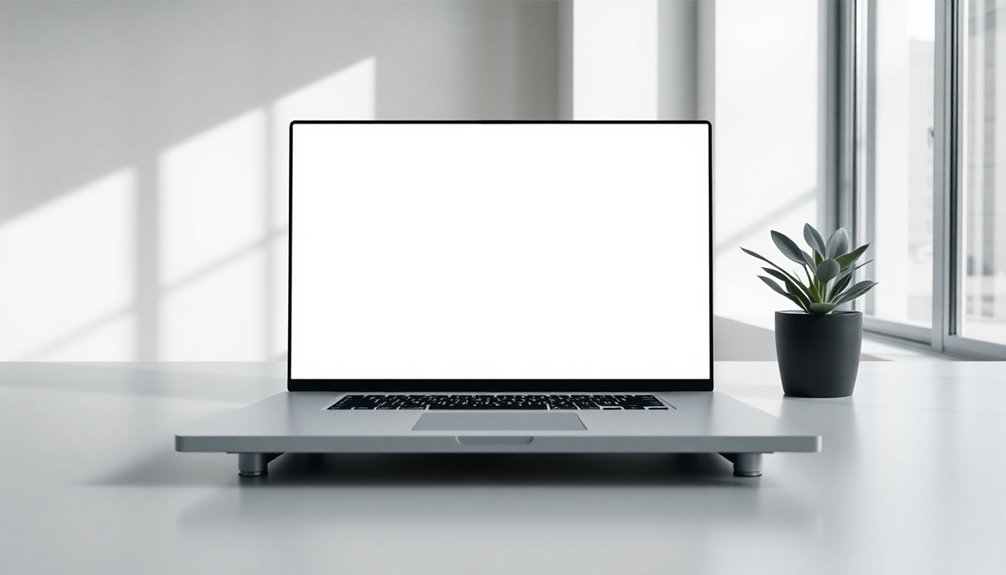
When you think about digital media, minimalism stands out as a powerful design philosophy that prioritizes clarity and simplicity. By adhering to minimalist design principles, you can create a user experience that highlights essential elements while reducing cognitive load.
Clean aesthetics not only enhance the visual appeal but also foster user trust, echoing the credibility seen in platforms like Apple and Google. As mobile-friendly designs become increasingly crucial, embracing minimalism guarantees that your content is accessible and engaging across devices.
Users prefer uncluttered interfaces, and studies show that fast-loading pages keep them from abandoning your site. Additionally, the rise of decentralized applications has made it even more important to ensure that your designs are intuitive and efficient. Ultimately, prioritizing simplicity leads to a more enjoyable digital experience, meeting user expectations effectively.
The Impact of Minimalist Design on User Engagement
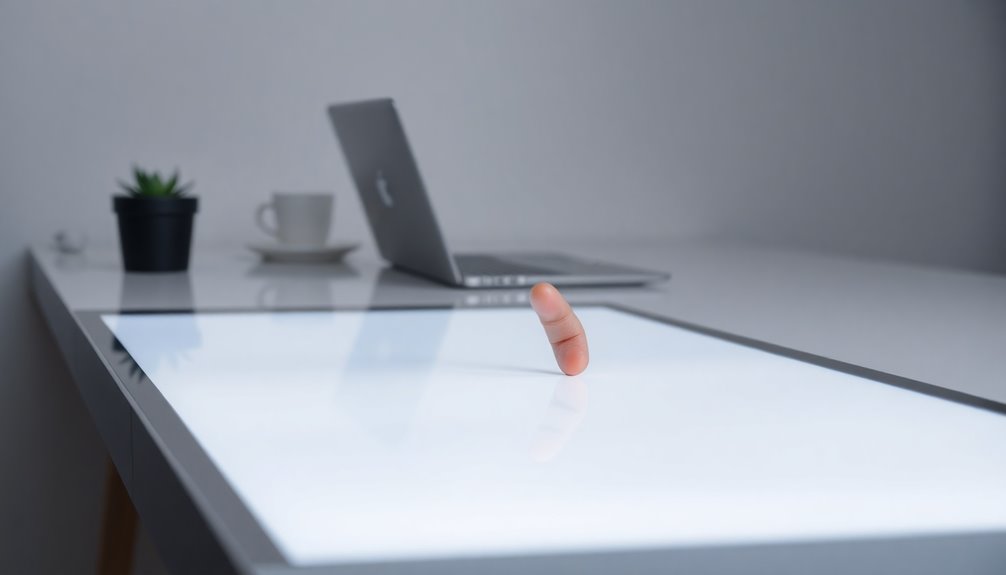
Minimalist design greatly impacts user engagement by streamlining the way users interact with digital content. By reducing cognitive load, it makes processing information easier and enhances your overall experience.
Research shows that 62% of users prefer clean, uncluttered interfaces, which boost user engagement greatly. With simplified navigation and clear calls to action, you're more likely to convert and take desired actions.
Faster loading times, another key benefit of minimalist design, keep users from abandoning sites; 53% of mobile users leave if a site takes longer than three seconds to load. Additionally, user preferences indicate a strong shift towards designs that prioritize functionality and clarity, reinforcing the importance of minimalism in modern digital environments.
Enhancing Functionality Through Simplicity
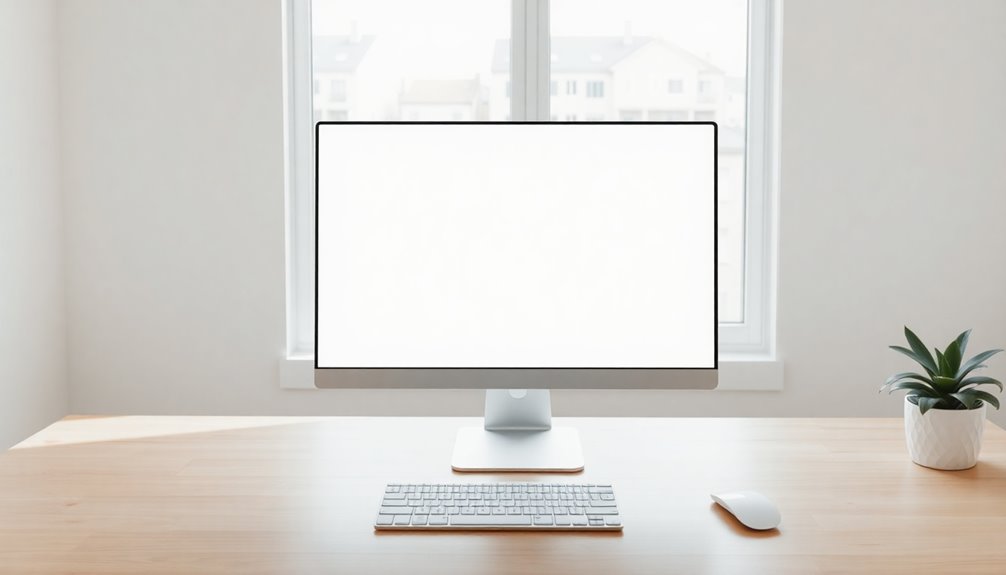
Simplicity in design can dramatically enhance functionality, making it easier for users to navigate and interact with digital content. By embracing minimalist design, you focus on essential features, reducing cognitive load and improving user experience. This leads to clearer navigation, which 62% of users prefer, and faster loading times that keep your audience engaged. Additionally, implementing water efficiency measures in your digital media strategy can create a more sustainable environment and appeal to eco-conscious users.
| Benefit | Impact |
|---|---|
| Reduces cognitive load | Increases processing speed |
| Clear navigation | Boosts usability |
| Fast loading times | Enhances engagement |
| Essential features | Improves conversions |
| Simplified layouts | Elevates accessibility |
With a streamlined approach, you're not just designing; you're enhancing functionality and ensuring users can easily access what they need.
The Role of White Space in Digital Interfaces

White space isn't just empty space; it's a powerful tool that enhances readability and helps you focus on important content.
By guiding your navigation intuitively, it makes finding information effortless and enjoyable.
When used effectively, white space balances visual elements, creating a clean and engaging interface that draws you in. This concept aligns with the principles of mindful art of decluttering, promoting clarity and focus in both digital and physical environments.
Enhancing Readability and Focus
When designing digital interfaces, incorporating ample negative space can greatly enhance readability and focus.
White space allows text and visual elements to breathe, increasing information retention by up to 20%. By reducing cognitive load, you make it easier for users to process information, ultimately improving user satisfaction.
Studies show that interfaces with sufficient white space can boost user engagement by 30%, providing a clearer path for navigation and emphasizing essential content.
A minimalist design with well-structured white space not only leads to faster load times but also enhances accessibility. High contrast and simplified typography improve legibility, making content more inclusive for users with varying visual abilities.
Incorporating lighting design principles from interior design can further enhance the overall user experience by creating a more inviting digital environment.
Embrace white space to elevate your designs and create a better user experience.
Guiding User Navigation Intuitively
A clean design not only boosts readability but also plays a significant role in guiding user navigation intuitively.
By using white space effectively in minimalist design, you enhance visual hierarchy, enabling users to focus on essential elements without distractions. This uncluttered approach reduces cognitive load, making it easier for you to navigate and interact with content.
Studies show that users retain information better from clean interfaces, and 62% prefer these layouts for their simplicity.
Additionally, ample white space contributes to fast page load times, as fewer visual elements need processing.
Ultimately, when you prioritize white space, you create an environment that fosters seamless user navigation and enhances overall digital experiences. Moreover, understanding interest rates can help you make informed decisions about online purchases and investments.
Balancing Visual Elements Effectively
Effective use of white space in digital interfaces can dramatically enhance the balance of visual elements.
In minimalist design, white space allows users to focus on content without distractions, boosting comprehension and retention by up to 20%.
By incorporating ample white space, you improve user navigation, clearly delineating sections and making calls to action stand out.
Clean layouts with sufficient white space not only create a sense of elegance but also contribute to faster loading times—critical for retaining users, as 53% abandon sites that load slowly.
Ultimately, embracing simplicity and functionality through effective white space fosters the clean, uncluttered interfaces that 62% of users prefer, ensuring a more engaging digital experience. Additionally, the growing complexity of algorithms in digital media emphasizes the need for clear and concise design to enhance user experience.
Visual Hierarchy and Its Importance in Minimalism

Clarity is essential in minimalist design, and visual hierarchy plays an important role in achieving it. By utilizing size, contrast, and positioning, you can direct user attention towards critical elements, ensuring they're easily identifiable.
Larger headlines and prominent calls to action enhance clarity, boosting engagement and conversion rates. The strategic use of white space emphasizes key content, allowing users to process information effectively while reducing cognitive load.
Maintaining a consistent visual hierarchy across devices is crucial for a uniform user experience, which fosters trust and strengthens brand identity.
A consistent visual hierarchy across devices enhances user experience, fostering trust and reinforcing brand identity.
Research shows that effective visual hierarchy not only improves user retention but also encourages users to stay longer on sites that present information clearly and organized in the domain of digital media. Moreover, high-quality content significantly enhances user engagement, making it vital for successful minimalist designs.
Speed and Performance: The Minimalist Advantage
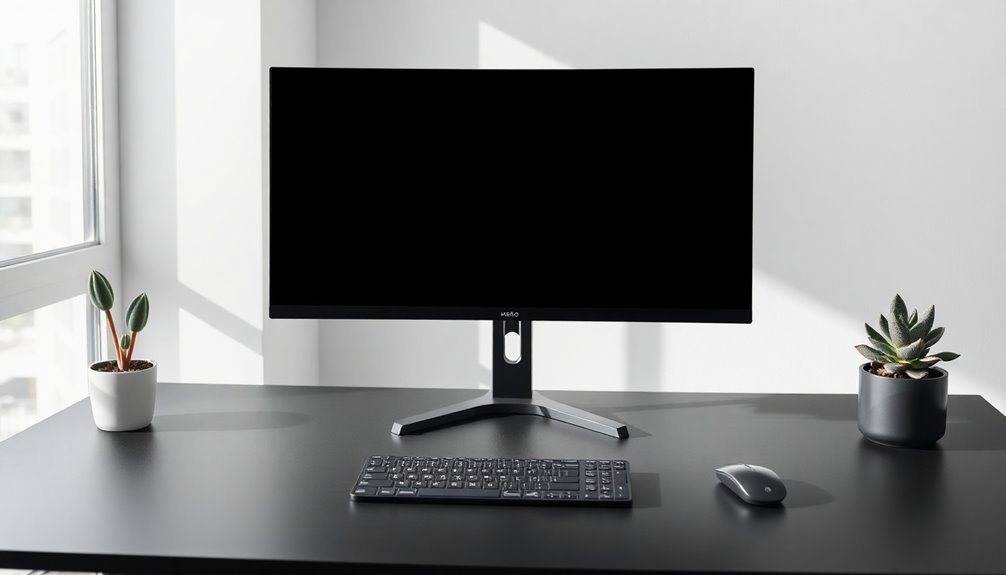
When you embrace minimalist design, you're not just simplifying aesthetics; you're also boosting your site's speed.
Faster load times keep users engaged and reduce the chances they'll bounce away.
This streamlined approach not only enhances user retention but also meets the growing demand for swift digital experiences. Additionally, high refresh rates in visual media can further enhance the user experience by providing smooth transitions and reducing motion blur.
Faster Load Times
While many factors contribute to a website's success, faster load times stand out as an essential element, especially in minimalist design. By using fewer visual elements and embracing white space, you can greatly improve site speed and enhance overall performance.
A cluttered website often leads to higher bounce rates, with studies showing a 32% increase in abandonment as load times stretch from one to three seconds. Minimalist design mitigates this risk by reducing heavy visuals and unnecessary components, ensuring a seamless user experience.
Cleaner code structures also boost site speed, making it easier for search engine crawlers to index your pages effectively. Additionally, adopting HEPA filters in air purification systems can further enhance indoor air quality, creating a more comfortable environment for users while they browse. Ultimately, adopting minimalist principles not only quickens load times but also elevates your website's effectiveness in retaining visitors.
Enhanced User Retention
Faster load times directly influence user retention, making speed a key advantage of minimalist design.
When you opt for a minimalist layout, you reduce heavy visuals and unnecessary elements, ensuring faster access to content. This is vital, as users are 53% more likely to abandon a site if it takes longer than three seconds to load.
With minimalist design, you'll also benefit from improved content focus through effective use of white space, keeping users engaged longer.
As your load times decrease, you'll notice a positive impact on user retention and even search engine rankings, thanks to cleaner code that allows for easier indexing.
Embrace minimalist design to enhance your digital media's performance and retain more visitors.
Aligning Brand Identity With Minimalist Principles
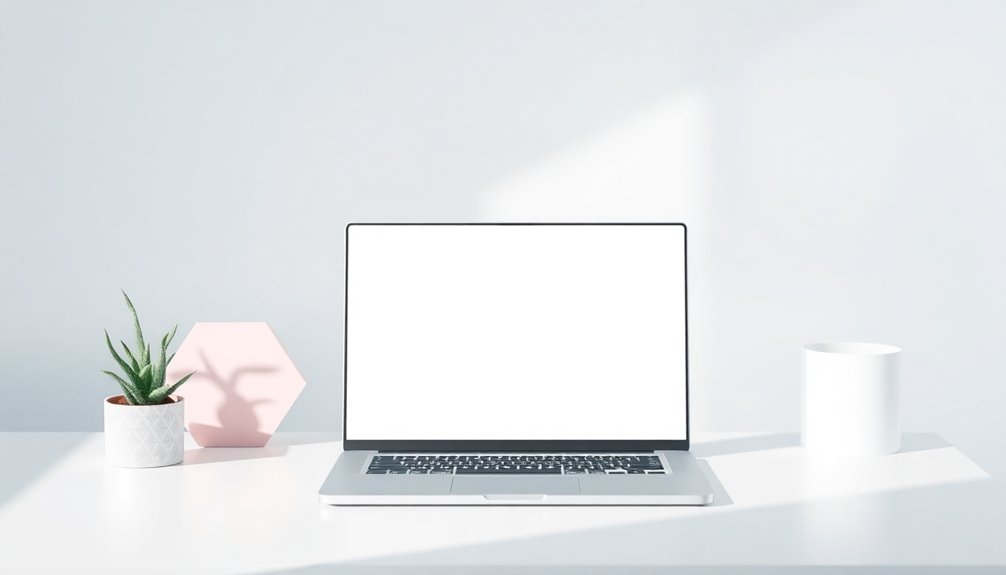
To effectively align your brand identity with minimalist principles, it's crucial to focus on clarity and intent in every design element. Embracing a modern aesthetic, your visual identity should eliminate distractions, fostering user engagement and deeper connections with your brand's core values. Brands like Airbnb highlight how minimalist design can communicate sophistication while remaining functional.
| Focus Area | Strategy |
|---|---|
| Clarity | Confirm every element has purpose |
| Visual Identity | Maintain consistency across platforms |
| User Engagement | Create clean interfaces |
| Brand Recognition | Prioritize simplicity |
The SEO Benefits of Minimalist Design

When you adopt a minimalist design, you're not just simplifying aesthetics; you're also boosting your site's SEO.
Faster page load times and a cleaner code structure help search engines index your content more effectively.
Plus, with improved mobile friendliness, your site stands a better chance of ranking higher in search results.
Faster Page Load Times
As mobile users increasingly expect quick access to information, minimalist design emerges as an important strategy for enhancing page load times.
By limiting visual elements and reducing file sizes, minimalist design notably speeds up loading processes, vital since 53% of mobile users abandon sites that take over three seconds to load.
This cleaner, more organized code not only boosts user experience but also enhances SEO performance, making it easier for search engines to index your site.
Prioritizing essential content reduces clutter, leading to faster interactions.
As page load times improve, you'll see higher retention rates, keeping users engaged and encouraging repeat visits.
Embracing minimalist design can truly transform your digital presence and success.
Improved Mobile Friendliness
Minimalist design greatly boosts mobile friendliness, which is vital in today's digital landscape where 94% of UK adults access the internet primarily through smartphones.
By reducing the number of elements on a page, minimalist design enhances user experience, ensuring simple navigation and quick access to important content.
Faster loading times are essential, as 53% of mobile users abandon sites that take longer than three seconds to load.
With fewer elements to index, minimalist web design allows search engines to efficiently navigate and rank pages, improving SEO performance.
The focus on important content aligns with Google's mobile-first indexing strategy, leading to reduced bounce rates and increased user engagement.
Embracing minimalist design is a smart move for optimizing mobile friendliness.
Cleaner Code Structure
A cleaner code structure is one of the standout advantages of minimalist design, greatly benefiting your SEO efforts.
By focusing on essential content and reducing unnecessary elements, minimalist design enhances site speed, making your pages load faster. This streamlined approach not only improves user experience but also makes it easier for search engine crawlers to index your content, boosting visibility in search results.
With fewer distractions, visitors are more likely to engage, leading to lower bounce rates. Additionally, minimalist designs align with Google's mobile-first indexing, further improving your rankings for mobile users.
To conclude, embracing minimalist design can profoundly impact your search engine optimization strategy, creating a more efficient and effective online presence.
Future Trends in Minimalist Digital Media
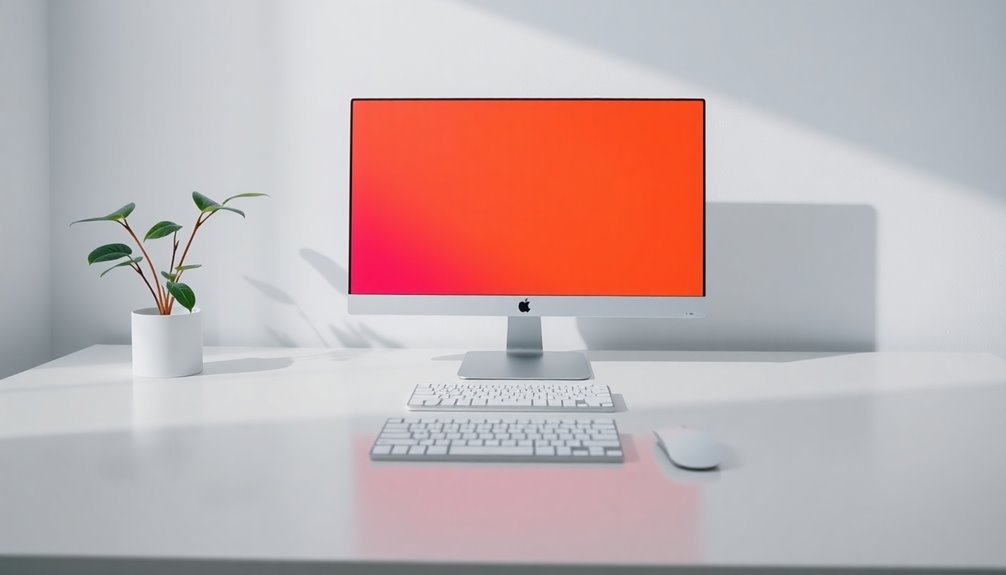
While trends in digital media constantly evolve, the future of minimalist design is shaping up to be more engaging and user-friendly than ever.
Bold typography will dominate, emphasizing impactful messages that make it easy for you to grasp key information quickly. Monochrome color palettes, often enhanced with subtle gradients, will create depth without overwhelming your experience.
Bold typography and monochrome palettes will enhance user experience, delivering impactful messages with clarity and depth.
You'll find that whitespace plays a vital role, guiding your interactions and ensuring a balanced, uncluttered layout that boosts readability.
Sustainable design practices are on the rise too, prioritizing eco-friendly approaches that minimize environmental impact.
Challenges and Considerations in Minimalist Design
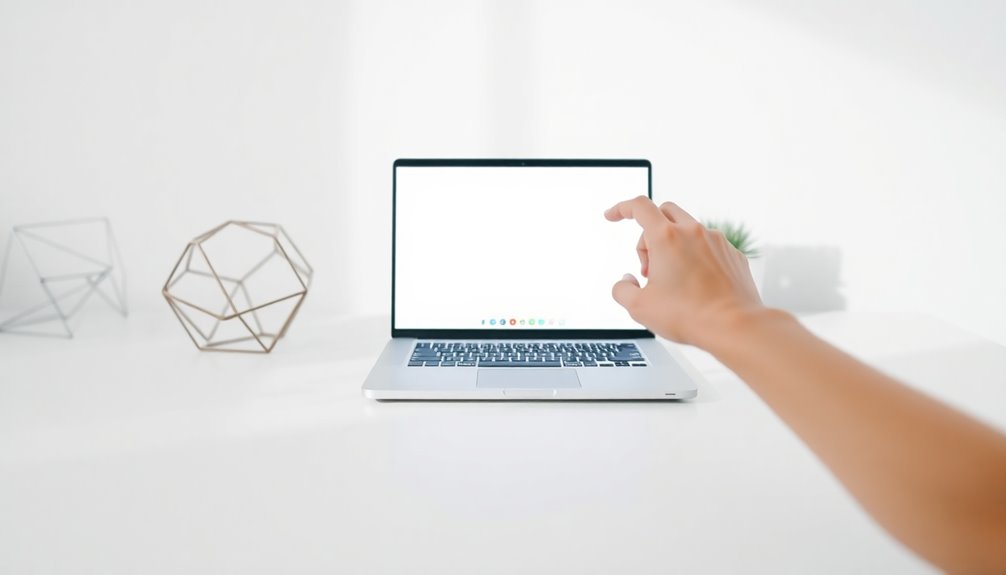
As designers embrace minimalist principles, balancing simplicity with functionality becomes fundamental. Each choice you make carries more weight, demanding creativity and precision.
Users accustomed to rich interfaces might struggle, leading to frustration and decreased user engagement. It's imperative to guarantee that performance isn't compromised; your design must deliver an effective user experience without sacrificing speed or usability.
Selecting essential elements that communicate brand identity while maintaining simplicity is key, as overwhelming users can increase cognitive load.
Additionally, you may face resistance from those who prefer complex interfaces, highlighting the need to clearly communicate the benefits of minimalist design.
Ultimately, fostering an intuitive user journey is essential to overcoming these challenges and enhancing overall engagement.
Frequently Asked Questions
How Can Minimalist Design Improve Accessibility for Users With Disabilities?
Minimalist design can greatly improve accessibility for users with disabilities by reducing visual clutter.
When you simplify layouts and limit distractions, it becomes easier for everyone to focus on essential content. Clear typography and high contrast help visually impaired users navigate more effectively.
Additionally, straightforward navigation promotes intuitive interactions for those with cognitive challenges. By prioritizing essential elements, you guarantee that your design is inclusive, making digital experiences more enjoyable for all users.
What Are the Best Tools for Creating Minimalist Digital Designs?
They say, "Less is more," and when it comes to creating minimalist digital designs, you've got some great tools at your fingertips.
Adobe XD and Figma are fantastic for wireframing and prototyping. Canva's user-friendly interface makes it easy to design simple graphics.
For web design, consider using Webflow or Squarespace. With these tools, you can streamline your process and focus on clean, effective visuals that enhance user experience.
How Does Minimalist Design Affect Website Loading Times?
Minimalist design can greatly enhance your website's loading times. By reducing clutter and limiting the number of elements, you're minimizing the data your site needs to load.
Fewer images, simpler layouts, and streamlined code mean faster performance. When you focus on essential components, you're not just improving aesthetics; you're also creating a more efficient user experience.
This efficiency can lead to better engagement and higher retention rates for your visitors.
Can Minimalist Design Be Applied to Social Media Platforms?
Oh sure, because who doesn't want their social media filled with just a few words and one sad emoji?
But seriously, minimalist design can totally work on social platforms. By stripping away clutter, you can focus on what really matters—connecting with friends and sharing your life.
Simple layouts and fewer distractions make it easier for you to engage, leading to a more meaningful experience.
What Industries Benefit Most From Adopting Minimalist Design Principles?
You'll find that industries like technology, fashion, and hospitality benefit greatly from adopting minimalist design principles.
In tech, streamlined interfaces enhance user experience.
In fashion, simplicity highlights key pieces and boosts brand identity.
For hospitality, minimalist aesthetics create calming environments, drawing in customers seeking relaxation.
Conclusion
In a world where digital distractions abound, embracing minimalist design can lead to a more meaningful media experience. By prioritizing simplicity, you'll not only enhance user engagement but also align your brand's identity with clarity and purpose. As you navigate future trends, remember that less truly is more. So, simplify your strategy, streamline your visuals, and savor the success that comes from a clean, enchanting, and compelling digital presence.
